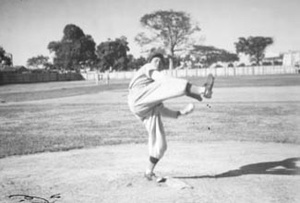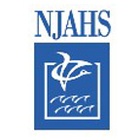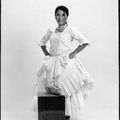As World War Two came to an end, Japanese Americans began the slow process of moving from internments camps to rebuild lives in the Midwest, along the West Coast and across the country. They re-established farms and businesses, found jobs in neighborhoods where they’d once been strangers. Yet in one field of endeavor, Japanese American faces were noticeably absent. No Asians were among the line-ups in one of America’s more popular sport—baseball.
“There was just one,” says 80-year-old Jose Nakamura Homma, reminiscing in the neat parlor of his modest home near Colon, Cuba. He holds up one finger with pride. “Yo era el unico,” he repeats, “the only one, a Japanese Cuban.”
Nakamura was working on his father’s flower farm when he was recruited in 1947 by international scout Joe Cambrio. For the next ten years he toured the US as a member of several semi-professional American ball clubs, representing the Nikkei devotion to baseball at a time when American-born Japanese were an anomaly in pro sports. During summer, he played with teams ranked class B to double-D, happy for any opportunity to show off his flashy pitching style. He joined the Tampa Smokers, the Apaches de Laredo, the Shelby Farmers and teams in Abilene, Charlotte and Louisville. In winter, he traveled south to play in Colombia, Venezuela, Mexico and other Latin countries.
Nakamura summarized his life in baseball during a visit with Tsukimi-kai, a group of San Francisco Bay Area Nikkei that traveled to Cuba in August 2005, sponsored by National Japanese American Historical Society, to celebrate Obon odori and collect oral histories of Cuban Nikkei. Along with so many Nikkei immigrants who’d adopted baseball as their national sport, Nakamura joined a youth league when he was 16 and signed with the Havana Cubans team two years later. “Baseball was my reason for being,” he says. Besides, the $300-a-week pay was a royal sum in those days, and “wherever we went, we ate well,” Nakamura recalled.
He honed his pitching skills stateside, perfecting the slider, the sinker and the curveball. He changed his name to “Joe Naka”—easier for Americans to pronounce, he explained—but his easy-going, hip-swinging delivery earned him various nicknames, too. He was “El Tornado Japonese” (the Japanese Tornado) and “El Pitcher de Merecumbe” in recognition of his dance-like moves on the mound. A combination of two popular dance forms, the merengue and cumbia, were devised in his honor, performed to a song lauding his pitching form, and became a hit during his Latin American appearances.
“When we played, we played every night,” he said. “I played so much, I didn’t feel the pain.” Contract problems ended his baseball career in 1958. Nakamura managed a sugar processing factory and continued to promote Cuban baseball history. Artifacts from his pitching days fill and exhibit in a museum in Colon, and journalists, especially fans from Japan, continue to seek him for interviews. He receives them in his living room, the front door open to the street, a blue Adidas cap perched on his head, his lanky frame still straight and strong with energy of many years devoted to the sport he loved.
Interview videotaped by Robert Yee, Tsukimi-Kai, August 2005.
* This article was originally published in Nikkei Heritage Vol. XVIII, Number 2 (Winter 2006), the journal of the National Japanese American Historical Society.
© 2006 National Japanese American Historical Society





